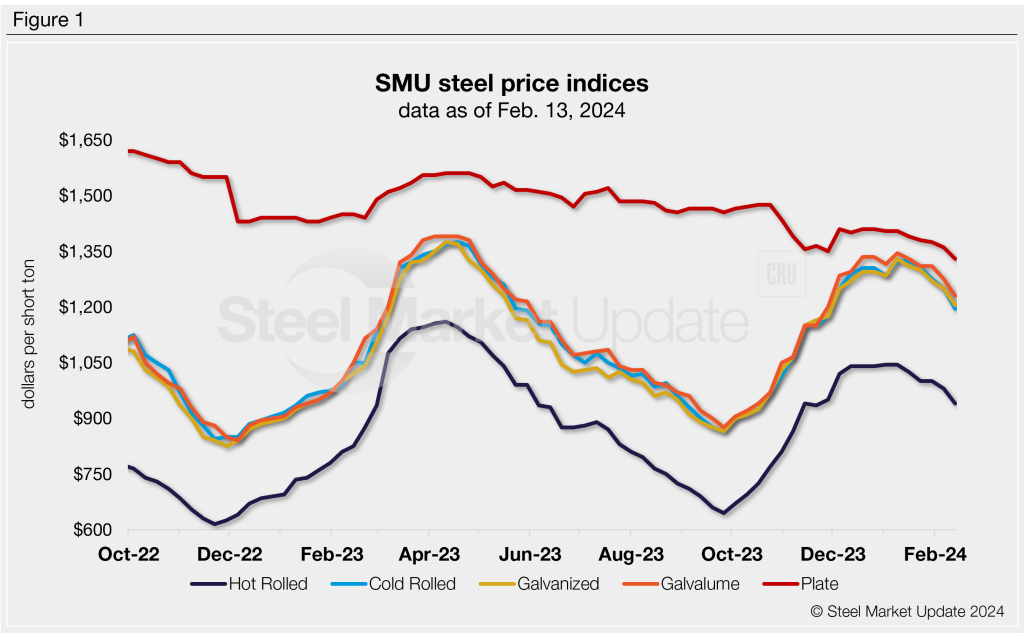Steel Prices

SMU price ranges: Sheet price drop accelerates
Written by David Schollaert & Michael Cowden
February 13, 2024
The pace of sheet price declines accelerated this week as steel buyers said that domestic mills were competing against each other while also coping with higher-than-expected import volumes.
“They are getting rid of the fluff. When you can pit 2-3 mills against each other, the fat margins get cut,” one industry source said.
Contributing to weakness in sheet prices were shorter lead times and weak February scrap prices. Some buyer sources in addition cited higher inventories and more material on order than usual. The result: Consumers are in no rush to return to the spot market. (SMU will release service center shipment and inventory data on Feb. 15.)
SMU’s hot-rolled (HR) coil price now stands at $940 per short ton (st) on average, down $40/st from last week and down $105/st from the beginning of the year.
Cold-rolled (CR) and coated products followed a similar downward trajectory. Our cold-rolled coil price is at $1,195/st on average, down $55/st from a week ago. Galvanized base prices stand at $1,205/st, down $45/st. Galvalume base prices also fell $45/st to $1,230/st on average.
SMU’s plate prices stand at $1,330/st on average, down $30/st from last week. The declines there follow a price decrease announcement from Nucor. And some sources predicted that the steelmaker might announce another round of plate price cuts.
SMU’s momentum indicators for all sheet and plate products remain pointed lower.
Hot-rolled coil
The SMU price range is $900–980/st, with an average of $940/st FOB mill, east of the Rockies. The bottom end of our range was down $20 per st vs. one week ago, while the top end of our range was down $60/st week over week (w/w). Our overall average is $40/st lower from last week. Our price momentum indicator for HRC remains lower, meaning SMU expects prices will move lower over the next 30 days.
Hot rolled lead times: 3–8 weeks
Cold-rolled coil
The SMU price range is $1,120–1,270/st, with an average of $1,195/st FOB mill, east of the Rockies. The lower end of our range was $80/st lower vs. the prior week, while the top end of our range was down $30/st. Our overall average is down $55/st from last week. Our price momentum indicator for CRC remains lower, meaning SMU expects prices will move lower over the next 30 days.
Cold rolled lead times: 6–9 weeks
Galvanized coil
The SMU price range is $1,140–1,270/st, with an average of $1,205/st FOB mill, east of the Rockies. The lower end of our range was down $60/st vs. the prior week, while the top end of our range was $30/st lower w/w. Our overall average is $45/st lower than the week prior. Our price momentum indicator for galvanized remains lower, meaning SMU expects prices will move lower over the next 30 days.
Galvanized .060” G90 benchmark: SMU price range is $1,237–1,367/st with an average of $1,302/st FOB mill, east of the Rockies.
Galvanized lead times: 5–10 weeks
Galvalume coil
The SMU price range is $1,160–1,300/st, with an average of $1,230/st FOB mill, east of the Rockies. The lower end of our range was $90/st lower w/w, while the top end of our range was unchanged from the prior week. Our overall average was down $45/st when compared to the previous week. Our price momentum indicator for Galvalume remains lower, meaning SMU expects prices will move lower over the next 30 days.
Galvalume .0142” AZ50, grade 80 benchmark: SMU price range is $1,454–1,594/st with an average of $1,524/st FOB mill, east of the Rockies.
Galvalume lead times: 7–8 weeks
Plate
The SMU price range is $1,280–1,380/st, with an average of $1,330/st FOB mill. The lower end of our range was down $40/st vs. the week prior, while the top end of our range was down $20/st w/w. Our overall average is down $30/st vs. one week ago. Our price momentum indicator for plate remains lower, meaning SMU expects prices will move lower over the next 30 days.
Plate lead times: 4-7 weeks

SMU note: Above is a graphic showing our hot rolled, cold rolled, galvanized, Galvalume, and plate price history. This data is also available here on our website with our interactive pricing tool. If you need help navigating the website or need to know your login information, contact us at info@steelmarketupdate.com.

David Schollaert
Read more from David Schollaert
Michael Cowden
Read more from Michael CowdenLatest in Steel Prices

HR Futures: Market at crossroads after turbulent run
The market appears to be pausing after a turbulent run. But tension remains just beneath the surface. With net long positioning still elevated, sentiment-driven selling could quickly reignite volatility. Still, supply constraints and limited imports are laying the groundwork for a resilient physical market. This moment of calm feels more like a crossroads than a conclusion.

CRU: Iron ore falls to a 7-month low on escalating trade war
Iron ore prices were largely steady in March, hovering around $100–102 per dry metric ton (dmt) in a quiet market.

SMU price ranges: Sheet and plate prices retreat from recent highs
Steel prices slipped again this week, with all five of SMU’s sheet and plate indices trending lower for the second week in a row.

Miller on Raw Materials: Iron ore tariff woes
There are several other tariffs implications concerning the ferrous raw materials sector. In addition to tariffs on DRI/HBI imports, there will be also be a tariff on raw materials imported to domestically based metallics producers.

Nucor lowers HRC CSP to $930/ton
Nucor lowered its weekly consumer spot price (CSP) for hot-rolled (HR) coil this week after holding prices steady for the past two weeks.
